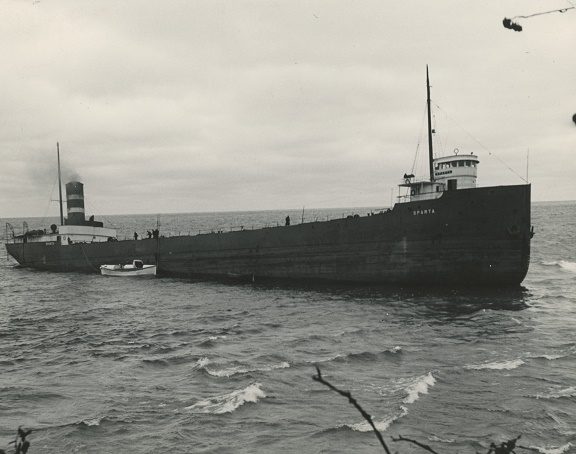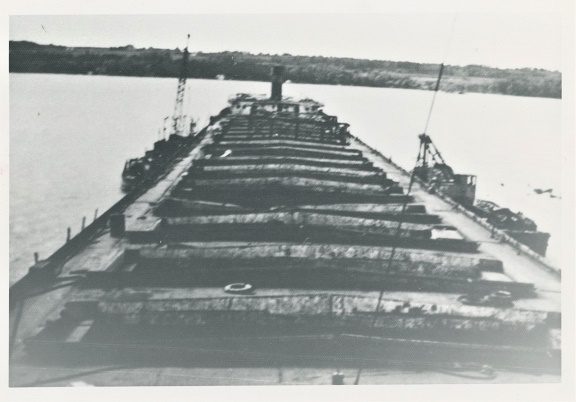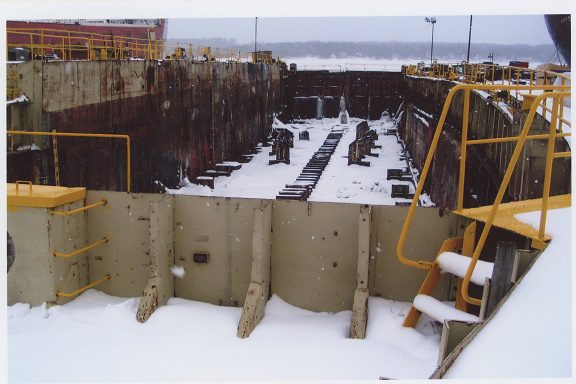On this day December 14, 1901, the steel steamer FRANK W. HART was launched by American Ship Building Company at Lorain, Ohio, for the Gilchrist Transportation Company. She was named for the head of one of the large wholesale millinery houses of Cleveland.
The HART was sold to the National Steamship Company in 1913, operated by the Tomlinson Lines in 1920 and renamed SPARTA in 1929.

SPARTA ashore on a reef at Mosquito Bay, November 5, 1940
On November 5, 1940, the SPARTA stranded on a reef in Mosquito Bay, 14 miles east of Munising, Mich., while trying to seek shelter in Grand Marais, during the Armistice Day blizzard. None of her crew of 31 were injured. She was abandoned on November 10th.
The SPARTA had been idle at Cleveland for several years prior to this but due to the great demand for vessels to transport ore and grain she was put into service this season. The following is part of the Milwaukee Journal’s article from November 10th on what happened to the SPARTA during this well-known blizzard.
“On the night of the storm the SPARTA, bound for Duluth without cargo, reached Stannard Rock northeast of Marquette, where ship’s officers decided to turnabout and try to reach shelter at Munising. As the ship turned it was noticed that she was listing and was taking in water. The run from Stannard Rock toward Grand Island was made with the gale on the SPARTA’s stern, and it was impossible for the captain to maneuver the boat into the east channel of Munising bay. When the boat reached Mosquito harbor and it was seen that she was going aground, the order was given for one of the reefs upon which the SPARTA went aground.
“Steamship inspectors tonight expressed the opinion that it was fortunate the SPARTA went aground exactly where it did and not at a nearby point, where it might have crashed directly into the cliffs of Pictured Rocks. …
“The SPARTA was not equipped with a ship-to-shore communication system. Communication between the scene of operations today and the Munising coast guard station was made by radio from the OSSIPEE and RUSH, U.S. patrol boat from Marquette, to Sault Ste. Marie and from the Soo coast guard station to Munising by telephone.
“While work proceeded, more stories were told of the experience of the crew of 31 and Captain Chester W. Danielson. Grounded Tuesday, they had to stay with the ship until Thursday morning before the lake was calm enough to permit them to row for help.
“They tried to attract attention by burning flares, oil and an old tarpaulin on deck. A hatch cover was burned, but no one saw it. …
“Crewmen told of the severity of the storm, of “thirty to forty-foot waves that crashed up, breaking half-inch angle irons and half-inch steel plates on the aft deck.” During the storm, members of the crew remained in the captain’s quarters in the bow as far away as possible from the incessant pounding on the stern, which was facing the incoming surf and “getting the worst of it.”
“The reef extends several hundred feet into the lake from shore and there is an abrupt drop-off.
“The OSSIPEE returned to the Soo and the RUSH returned to Marquette this afternoon, but the FAVORITE stood by and continued pumping operations through the night. Food supplies are being brought to the men from Munising by the Sand Point coast guard crew.”


SPARTA as a drydock at Bay Ship Building, March 19, 2005. Photo by Craig Olson
In December 1952, after laying idle since being salvaged after the above disaster, the SPARTA was converted into a floating drydock at Sturgeon Bay. In 1978 her hull was being used as a small boat and tug drydock on the old Roen property.
Suzette Lopez.
Photo credit: Great Lakes Marine Collection of the Milwaukee Public Library and Wisconsin Marine Historical Society.
This story was originally posted on December 14, 2023.

